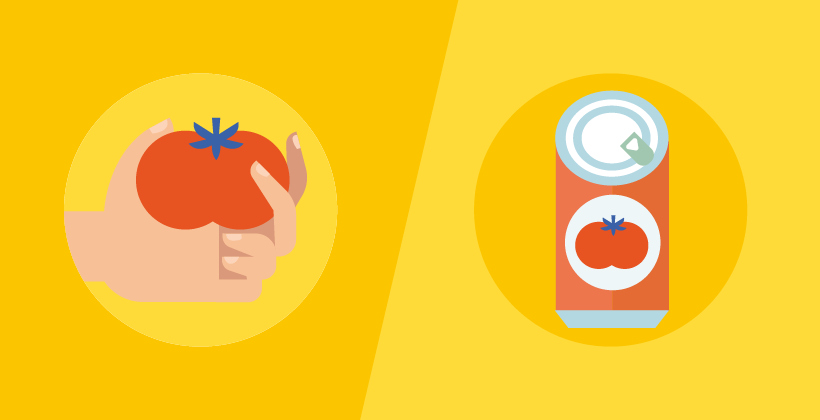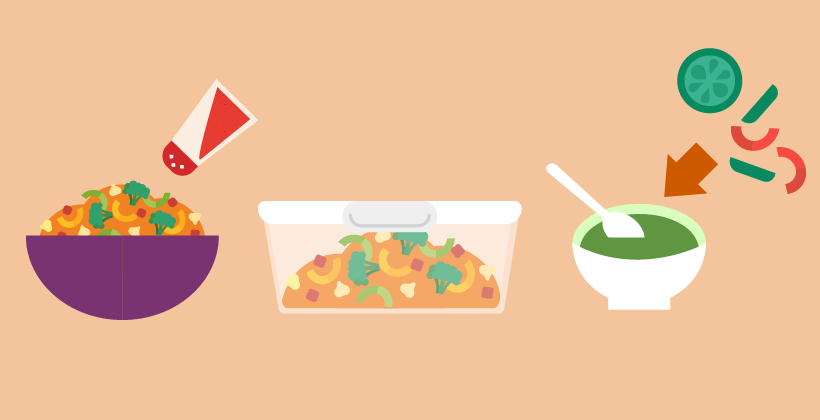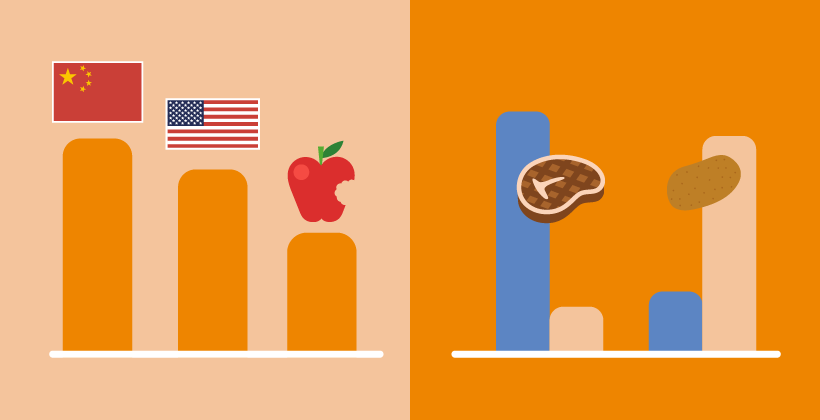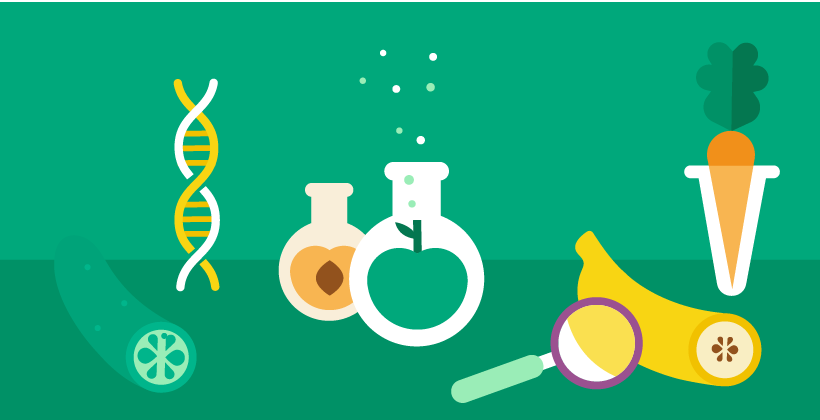What is processed food?
Last Updated : 17 April 2023“Avoid all processed foods” – this message seems to be a common response when someone asks how to adopt a healthier diet. The term ‘processed foods’ may bring to mind products such as frozen pizzas, packaged chocolate chip cookies, or ready-made supermarket meals containing many ingredients and food additives. However, food processing is often a necessary step to producing healthy, tasty, safe and sustainably-handled food for consumers.
In this article, we’ll cover what we mean when we talk about food processing and processed foods, explore both positive and negative effects of processing food, and give some tips on how to choose processed foods within a healthy and sustainable diet.
What is food processing?
While definitions can vary, one common definition of food processing is any action or procedure that changes the initial food or raw materials used to produce food (such as crops, water and so on).1 This can involve one or a combination of processes such as washing, chopping, pasteurising, freezing, fermenting, packaging, heating, milling, extruding, or adding ingredients to foods, for example to extend storage life. Processing can also refer to the transformation of ingredients into food products, for example making bread. Food processing can take place both at home, out-of-home (for example in restaurants and cafeterias), and at an industrial scale. By this definition, it becomes clear that the majority foods we consume in our day-to-day lives are processed to some extent.
Food is processed for many reasons that are beneficial.1 These include:
- Preserving or enhancing the nutritional content of foods (e.g., fermenting vegetables,),
- making a food digestible or making components more available to the body (e.g., milling grains to flour, cooking beans and lentils, increased availability of lycopene in processed tomato products),
- making food safe to eat (e.g., pasteurising milk),
- prolonging shelf-life (e.g., sterilisation, addition of preservatives), reducing food waste or making produce available all-year round (e.g., canning or freezing),
- altering the colour, taste, or texture (e.g., browning or caramelisation, adding food colours or flavourings, or thickeners or emulsifiers).
- producing foods for specific dietary needs (e.g., lactose-free dairy alternatives) and nutrient requirements (e.g., fortification with vitamins or minerals).
- increasing convenience and time saving (e.g., ready-meals, partially cooked foods, pre-washed salad bags)
- contributing to sustainability goals and food security by producing alternatives to animal products/protein (e.g., plant-based meat and dairy alternatives).
However, next to its benefits, food processing can also potentially bring undesired consequences. These are explained in the section ‘what are processed foods to avoid?’
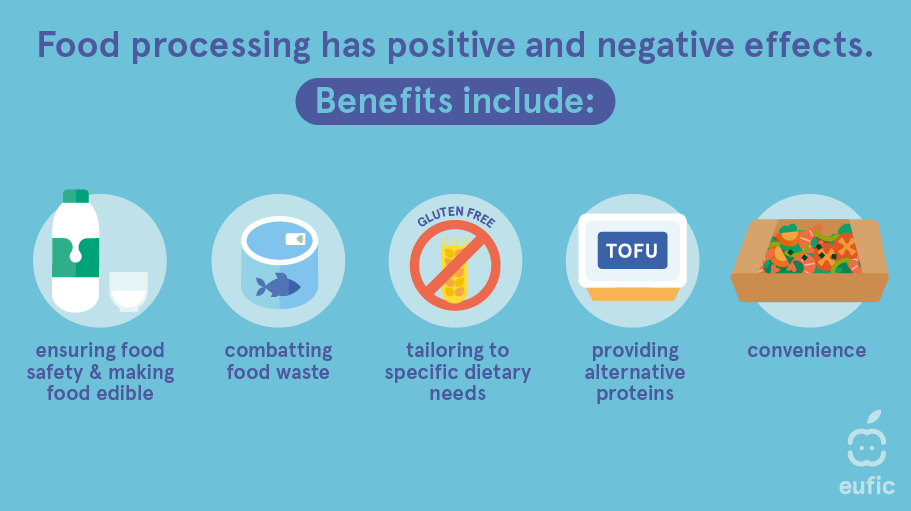
What are processed foods?
‘Processed food’ generally describes any food that has been altered from its natural state.2 However, you may come across slightly different descriptions as there is not one accepted definition among scientists.3
What are mildly or minimally processed foods?
‘Mildly’ or ‘minimally’ processed foods are often described as treating the food ‘as little as possible, but as much as necessary,’ to preserve or enhance nutritional and sensory quality (e.g., colour, taste, or texture) and guarantee food safety.4 Minimally processed food has also been defined as retaining most of its inherent physical, chemical, sensory and nutritional properties, for example bagged lettuce, cut vegetables, frozen fruits or roasted nuts.5
What are ultra-processed foods?
The term ‘ultra-processed food’ was introduced by the NOVA classification system, which defines it as “formulations of ingredients, mostly of exclusive industrial use, made by a series of industrial processes, many requiring sophisticated equipment and technology”.6
However, this definition is not universally agreed upon by food scientists. The NOVA classification has been criticised for being difficult to apply consistently,7 and of incorporating aspects other than processing in its classification of foods (for example the addition of ingredients like food additives, the use of low-cost ingredients or emphatic branding).6 There is also an on-going debate about the usefulness of the term “ultra-processed” when it comes to guiding consumers in their dietary choices.
For example, using the NOVA system, a wide range of foods can be classified as ultra-processed. In some cases, processing may make a food less healthy, for example by adding high amounts of salt or sugar. These are foods generally recommended to limit within a healthy diet (e.g., soft drinks, chocolate and fried snacks). However, some other examples, like wholemeal bread and vegetable-based sauces, may also be considered as ultra-processed foods and these can be part of a healthy dietary pattern.
What are processed foods to avoid?
Food processing can potentially have undesirable consequences. These may include:
- nutrient losses (e.g., milling grains to refined grains which causes some fibre to be lost, or heating, which can reduce vitamin C levels),
- the formation of toxic compounds (e.g., due to smoking, drying, refining or high temperature cooking),
- the addition of high amounts of fat, sugar, and/or salt and
- changes in food form (e.g., solid to liquid) that can lead to us to overconsume.1,8
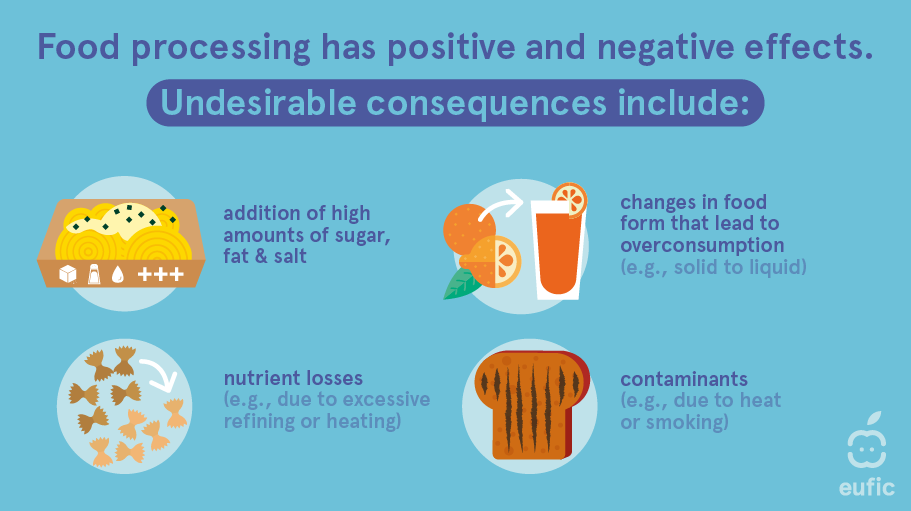
Recommendations on whether to limit or avoid processed food are highly dependent on the specific food and how it may affect our health. For example:
- Compared to meat in its fresh form, processed meats, like salami or sausages, are often high in salt, energy, saturated fats, cholesterol and other compounds formed or added during processing, which can be harmful if we eat too much.9,10 This is why most health authorities encourage people to eat little processed meat, if any. However, it is important to note that this is based on the specific characteristics of processed meat and is not necessarily true for processed versions of other foods, such as fruits and vegetables, where some processing methods may help retain nutrients.
- Many processed foods are energy-dense products, high in sugar, fats and salt. Diets high in fat (especially saturated and trans-fat), sugar and salt are associated with an increased risk of non-communicable diseases such as diabetes, heart disease, stroke and cancer.11 Furthermore, diets containing many energy dense foods can lead to high energy intakes and weight gain over time.12
- According to some classification systems, the presence of a food additive leads products to be classified as processed. However, additives undergo a rigorous safety evaluation by the European Food Safety Authority (EFSA) before being approved for use in products, and do not make a food product ‘unhealthy.’
Some studies have shown that consumption of foods categorised as ‘ultra-processed food’ has been linked with less healthy diets overall and with certain health outcomes.6,13,14,15 However, associations differ between different subgroups of UPFs. For example, while certain groups, such as animal products, sauces, spreads and condiments, and artificially and sugar-sweetened beverages have been found to be associated with increased risks, other groups, such as breads and cereals, have been associated with lower risks.15 This might be explained by the fibre content of such products.
Does food processing affect our food intake?
Changes in food form have also been linked with increases in energy intake which could lead over time to overweight and obesity.8 For instance, compared to solid foods, liquids require less bites or chewing and are therefore faster to eat. Take the example of grapes. When they’re squeezed into juice, the same number of grapes can be consumed 12 times faster compared to whole grapes. This eating speed influences how full we feel, which in turn determines how much we eat during a meal.
Another example is how the food form can affect the rate of food absorption. For example, foods high in fibre tend to slow down the digestion of carbohydrates and reduce fluctuations in blood glucose levels. However, many processed foods tend to use powdered ingredients (e.g. onion powder) and are therefore often low in fibre.
Additional research is needed to understand more about how a food’s thickness, hardness, lubrication and shape and size influences eating rate and intake before accurate and consistent guidance on their intakes can be recommended.16
The bottom line
Food processing is a broad spectrum that ranges from basic methods such as chopping or freezing, to multi-step transformation of ingredients into a final food product. It brings both benefits and unintended consequences, making it a complex topic. With many ways to process food, and combine ingredients, the resulting products can be very different and can bring both health benefits or risks. Some processed foods contain high levels of saturated fat, added sugar or salt, are calorie dense and may contain less fibre, and are therefore best consumed only occasionally. It can be useful to compare the food labels and check your national food guidelines for more information or suggestions on how to include processed foods in a healthy and sustainable diet.
To help you navigate the food environment and eat a healthy diet, here are some useful tips to keep in mind:
- Eat plenty of, and a variety of, plant foods (fruits, vegs, legumes, etc.)
- Choose whole grains over refined grains
- Choose nutrient-dense foods and limit foods and drinks high in fat, sugar and salt – check the nutrition label to help identify these!
- Replace saturated with unsaturated fats
- Eat little, if any, processed meats (e.g., salted, cured, fermented or smoked meat)
- Control portion sizes and eat mindfully
References
- Sadler C et al. (2021) Processed food classification: Conceptualisation and challenges. Trends in Food Science and Technology 112:149.
- Jones JM (2019) Food processing: Criteria for dietary guidance and public health? Proceedings of the Nutrition Society, 78(1):4–18.
- Sadler C et al. (2022) “Even We Are Confused”: A Thematic Analysis of Professionals' Perceptions of Processed Foods and Challenges for Communication. Frontiers in Nutrition, 9, 826162.
- Alzamora SM et al. (2016) Minimally Processed Foods. In Encyclopedia of Food and Health pp. 767–771. Elsevier. https://doi.org/10.1016/B978-0-12-384947-2.00470-0
- AGROVOC (2022) Minimally processed foods. AGROVOC Multilingual Thesaurus. Accessed 7 March 2023.
- Monteiro CA et al. (2019) Ultra-processed foods, diet quality, and health using the NOVA classification system. Rome, FAO.
- Braesco V et al. (2022) Ultra-processed foods: how functional is the NOVA system? European Journal of Clinical Nutrition 76:1245.
- Forde CG & Bolhuis D (2022) Interrelations Between Food Form, Texture, and Matrix Influence Energy Intake and Metabolic Responses. Current Nutrition Reports 11:124-132.
- Bouvard V et al. (2015) Carcinogenicity of consumption of red and processed meat. The Lancet Oncology 16(16):1599.
- World Health Organisation. Cancer: Carcinogenicity of the consumption of red meat and processed meat. Questions & Answers.
- World Health Organisation (2016) Healthy diet.
- Drewnowski A (2018) Nutrient density: Addressing the challenge of obesity. British Journal of Nutrition 120(s1):S8–S14.
- Hall KD et al. (2019) Ultra-processed diets cause excess calorie intake and weight gain: An inpatient randomized controlled trial of ad libitum food intake. Cell Metabolism 30(1):67-77.e3.
- Lane M et al. (2021) Ultraprocessed food and chronic noncommunicable diseases: a systematic review and meta‐analysis of 43 observational studies. Obesity Reviews 22(3): e13146.
- Cordova, R., Viallon, V., Fontvieille, E., Peruchet-Noray, L., Jansana, A., Wagner, K. H., ... & Freisling, H. (2023). Consumption of ultra-processed foods and risk of multimorbidity of cancer and cardiometabolic diseases: a multinational cohort study. The
- Tobias D & Hall K (2021) Eliminate or reformulate ultra-processed foods? Biological mechanisms matter. Cell Metabolism 33(12):2314–2315.



